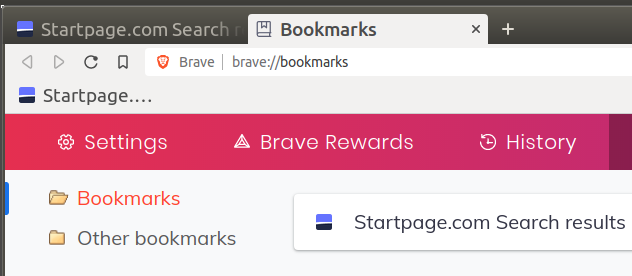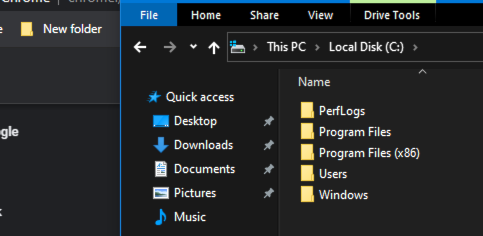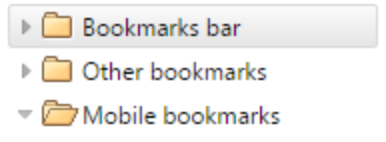I'm switching to Ubuntu mate from Windows 10. I want to use Brave browser because it has session buddy which doesn't exist in Firefox.
Bookmark folders in Brave in Ubuntu mate are grey instead of yellow like they are in Windows? I think this has something to do with a switch in chromium browsers a few years ago to a "Materials Design". Also has been discussed here. This reddit post talks about the same problem but the suggested fix no longer works.
Actually my bookmark folders are grey also in Google Chrome and when running in Manjaro KDE as well.
Is it possible to style the bookmark folders back to yellow like you can with a Firefox userchrome.css? Anyone know why they "look right" (i.e: yellow) in Windows but grey in Linux OS?
Cheers,
Flex
Nobody on here is using a Chromium browser in Ubuntu mate?
I'm just curious why the bookmark folders are grey instead of yellow and if anything can be done about it. Does that bother anyone?
Flex
The bookmark folders in Brave are yellow (Ubuntu MATE 21.04, Ambiant MATE theme).

Perhaps is the color of the icons dependent on the used theme.
Thank you for responding.
I am also using the Ambiant MATE theme. I tried a few different themes and they have no effect on the styling of the Brave UI.
Can you please create a bookmark folder on your Brave bookmarks toolbar?
Is it yellow or grey?
Flex
The "New Folder" on the "Bookmarks" bar is grey...

Thanks alot for confirming.
I searched around and I'm surprised there is very little discussion about this on the net. It would be interesting to know why bookmark folders are grey in Chromium browsers in Linux distros and is anything being done about it? I think they used to be yellow but then a change was made to Chromium browsers a few years ago so now they appear grey.
I don't see why they can be yellow in Windows and not Linux.
Flex
I'm using Brave only for specific actions.
First browser: Firefox, second browser: Vivaldi (a Chromium browser).
The "folder" icons on Vivaldi's Bookmark bar are grey, but a different icon:

The color of the folders on the Bookmark bar was never a great deal for me. I use some Windows PCs, too, but I really did not note the different colors.
It looks like Google Chrome for Windows uses the regular Windows folder icon - they look the same:

My guess is that on Linux, it's intentionally built with a flat icon because every distro ships different icon themes.
Historically, I do remember when Chromium/Chrome had icons like this on both platforms:

The source code (and its version control history) for Chromium will have all the answers. 
From quickly looking at the Chromium GitHub mirror of the source code, I couldn't find our  icon. I found the Windows
icon. I found the Windows  , Mac
, Mac  , and the old one
, and the old one  in this folder:
in this folder:
Theoretically, since Chrome is based on GTK, the developers could add some code to get the folder icon from the current theme, but I don't know the codebase so it might not be as straightforward as that.
Somewhere in the source code will have the answer. 
4 Likes
@lah7 Thanks for this really helpful information.
I had a look and there are instructions about how to check out and build chromium for linux and video tutorials too. That looks really daunting to me!
Still I wish some focus would be put on fixing this. I notice the Brave or Chrome Browser UI does not obey Linux themes but they should like Firefox does. In that case, as you say, Bookmark folders could be a colour that is much easier on the eyes.
Cheers,
Flex
Good luck finding someone who will implement full GTK theming in Chromium. I mean that sincerely. Here's why:
In ye olden days (i.e., about 12 years ago), Chromium actually fit in with the current GTK theme, sort of like it does on Windows even today. For some reason however, somebody decided GTK theming looked bad and removed the support. Now Chromium has very little reliance on GTK and isn't themed like GTK. In a way, Firefox has slowly been stepping in that direction for a long time now. One of the few browsers that does still have good GTK theming is Pale Moon, which was forked off from Firefox many years ago and has something of a... let's just say strong following by some and strong disrespect by others.
(Little off-topic note here: You can use Pale Moon if you want to, but since the project is run by only a handful of developers, you really cannot expect the browser to work on many modern Web pages. Furthermore, if you join the forum that they have and start posting there, be very careful about what you say. Many people, myself included, have posted there and made a few little mistakes, and now our reputations are soiled over a few lousy questions; there are some very, very abrasive individuals on the forum who use all kinds of deceptive, back-handed tricks to soil your reputation as far as the forum goes. However, the developers strictly insist that I say to you: I can't influence your decision making, so make up your own mind.)
All right, that was a little off topic. The most common reason for dropping GTK theming support that I've seen cited is that: GTK-based desktops used to be used by the majority of users 12 years ago, but no longer. KDE (which is based around a rival toolkit named Qt) is, according to some estimates, far more popular than GTK-based desktops today. As such, and considering that operating systems like Windows have their own officially solicited widget toolkits (whereas Linux does not), in some ways it's no wonder that browser designers stopped theming their applications using GTK; Qt is just as, if not more popular.
That's just my two cents, for whatever it's worth. Sure, you can probably convince somebody to write the necessary GTK support for you. But you can't expect your average Joe / Jane Blow Chromium developer to write it without a very convincing argument.
@gordon That's really interesting. I've only just made the switch to linux as my daily driver OS, after dabbling with Raspberry Pis for years. I've been reading alot and learning about all the options and it hasn't been easy deciding which distro/desktop combination was the right one for me.. and my 9yr old laptop!
So maybe the lack of standardisation across the linux world is holding back application developers (e.g: Chromium browsers) from giving linux users the same experience with their software that you get in Windows and Mac OS..
Flex
1 Like





